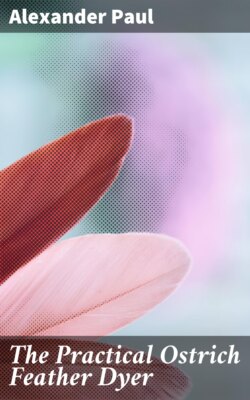Читать книгу The Practical Ostrich Feather Dyer - Alexander Bartlett Paul - Страница 7
На сайте Литреса книга снята с продажи.
THE BIRD, ITS PLUMAGE AND HABITS.
ОглавлениеTable of Contents
Years ago, before the trade had begun to assume its present proportions, the supply of feathers came chiefly from Egypt; the bird being hunted by the natives, and generally killed for its plumage, which was in quality far superior to the feathers which are to-day raised on farms at the Cape. The flues or fibres of the Egyptian were very close and compact and very strong in texture and of great durability, and having a great affinity for color, they were capable of standing a great amount of manipulation without receiving serious injury. A serious objection to them was that one-half, or more, were marked where the bird pecked them with his bill, giving them a moth-eaten appearance, and few of them could be used for white, as they were more or less stained on the ends, a dirty yellow, which soap would not remove and acid would only develop, there being at that time no known method of bleaching them, as the virtues of Peroxide of Hydrogen or Permanganate of Potash as bleaching agents were unknown to the dyers. Enterprising capitalists saw a profitable field for investment in the propagation of the bird, and, as a result, the supply has greatly increased, and the quality of the plumage is far superior in every respect to the wild Egyptian ostrich.
A full grown ostrich will weigh about three hundred pounds, and stands about seven to eight feet in height. In the breeding season they will travel in broods of from three to five in number, one of which is invariably a male. The hens lay their eggs in a pit scraped out with their feet, the sand forming a ridge around it. When they have accumulated a dozen eggs or so the male begins to brood, always taking his place on them at night, surrounded by the hens, while by day they will relieve one another. Again, at times the hatching has been left entirely to the sun. North African eggs present a smooth surface, while those of the South are pitted.
At the present time an ostrich farm is in progress in California; it is as yet a very young institution, and its success is being watched with interest, but, in my opinion, while the bird will live and thrive, the quality of the plumage will be very inferior to those in their native clime. So much has already been written concerning the bird's powerful digestive organs, and so exaggerated that we will not try to discredit or contradict it. It is hardly necessary to remark that there is scarcely enough substance in ten-penny nails or doorknobs to fatten an ostrich on.
